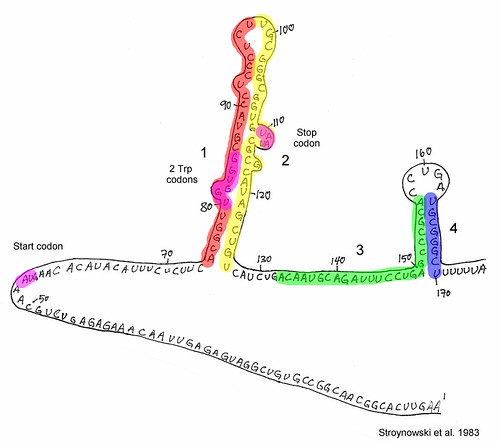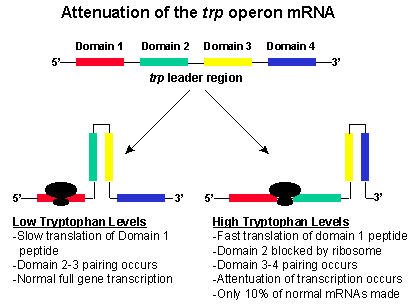Attenuator (genetics)
The ( transcriptional ) Attenuation is a form of gene regulation that occurs in the gene expression of prokaryotes, such as bacteria.
The transcription of DNA into mRNA is delayed in protein biosynthesis. This is done by ribosomes exert influence on the secondary structure of mRNA and thus determine whether the RNA polymerase of a attenuator region ( " attenuation region") can transcribe away.
A prerequisite for this mechanism, that the translation in the vicinity of the transcription takes place ( spatial and temporal coupling), and that the mRNA molecule is still transcribed as already sits a ribosome elsewhere same mRNA molecule. This may be the case only in prokaryotes, eukaryotes, since the DNA remains at all times in the nucleus (only mRNA leaves it) and then the translation out of the cell nucleus takes place ( spatial and temporal separation).
The stopping process arises from the fact that the mRNA by base pairing forms a loop. Thus, the further synthesis of mRNA is terminated at the bacterial chromosome itself by steric (spatial ) disability.
For example, the tryptophan operon in E. coli
The trp operon uses the attenuation as Genregulationsmethode. At high concentrations of the amino acid tryptophan in the cell, transcription is stopped. If the tryptophan levels dropped, so the transcription is again set in motion.
Within the mRNA transcript via hydrogen bonds mediated base pairs can form. Thereby, the normally single-stranded mRNA in a double-stranded portion. Certain stem-loop structures can terminate prematurely before the first structural gene of the operon ( trp ) is reached, or activate transcription.
Upstream of the stem-loop portion is a portion ( leader sequence ) that a ribosome must translate - consisting of 14 codons, 2 of which are tryptophan codons.
Is now enough tryptophan before, so can fully translate the tryptophan -containing leader sequence, a ribosome, the polymerase following. It forms a stem-loop structure I, which acts as a termination signal for the RNA polymerase, and transcription of the mRNA stops ( trpE gene trpA to are not transcribed - no tryptophan synthesis).
If too little tryptophan is present, the ribosome to the translation of the leader sequence requires much more time, since the incorporation of tryptophan kinetically considered rare in the leader sequence takes place than with tryptophan excess. Only when tryptophan could be installed with a relative time delay, the ribosome moves on. This time delay in the translation will result in a stem-loop structure II in the downstream clutch ligand attenuator sequence of the transcript, which as a signal to the RNA polymerase to complete transcription of mRNA ( all reading frames trpE to trp ), and then the translation of the mRNA leads to the production of the target gene to TrpE TrpA and consequently for tryptophan synthesis.
There are other operons, in which attenuation occurs, for example, the phenylalanine operon or operon for histidine, leucine, and threonine.










